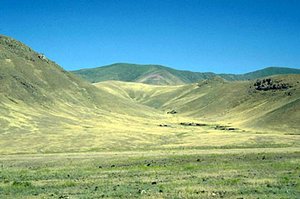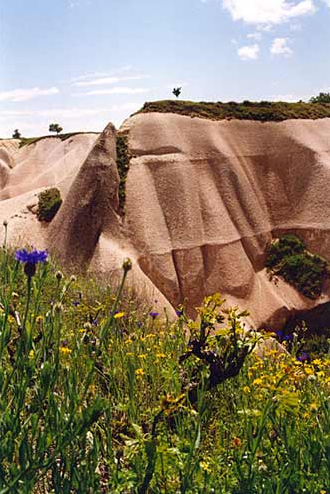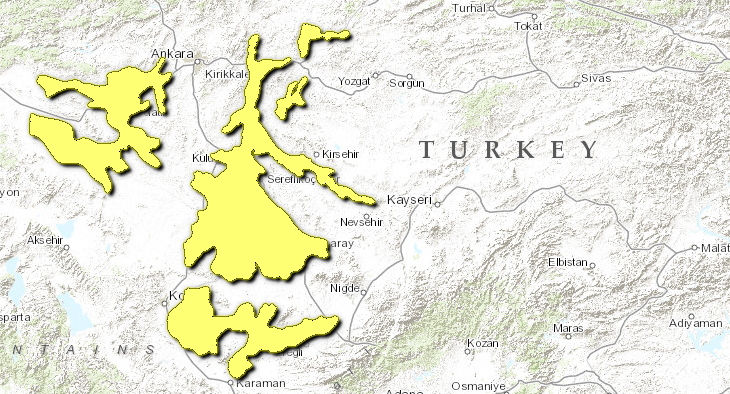Central Anatolian steppe
Introduction This unique region (Central Anatolian steppe) of the central Anatolian basin hosts salt steppe, saline lakes and halophytic vegetation as well as marshes, rivers and freshwater (Freshwater biomes) bodies. It represents one of the centers of endemism of the diverse Anatolian flora, with 12 vascular plant taxa endemic to the area's central lake. Ten Important Bird Areas, all wetlands, support a diversity of residents and migrants. Threatened birds include the great bustard and the little bustard. An endemic fish species lives in the basin, and threatened species such as the marbled polecat also inhabit the area. The principal threats are posed by diversion of the areas water resources and conversion to agriculture.
Location and General Description
This ecoregion is largely comprised of three separate areas of steppe vegetation in central Anatolia. The largest area is dominated by Tuz Lake and lies in the center of the Anatolian basin. The northern and eastern edges of this area are defined by a long arch in the K?z?l?rmak River, the biggest river in Anatolia. This arch starts from the Cankiri environs to the north of Tuz Lake and extends to the Nev?ehir environs in the east. The second area of this ecoregion lies in the Karap?nar Plain to the south of Tuz Lake and is separated from the central area by the Obruk Plateau. This area represents the southernmost reaches of the ecoregion. The Porsuk and Sakarya River basins comprise the third and westernmost area of the ecoregion, which is separated from the central area by the Haymana and Cihanbeyli Plateaus.
These three areas of central Anatolian steppe are almost completely enclosed within an area where deciduous forests represent the primary vegetation type. The principal feature that distinguishes this steppe region from the surrounding deciduous forests ecoregion is the absence here of any woody formations. This area is known as "true steppe"; the surrounding region is accepted as an anthropogenic steppe because it has lost its woody cover due to human activity.
There are no mountains or highlands here, and the average altitude is around 1,000 meters (m). Plains and river basins constitute the dominant land formations, with their boundaries determined by plateaus. The main geological formation of the area consists of young alluvial deposits. These are Oligocene formations of gypsum and saline. As in the surrounding deciduous forest region, the continental climate that prevails here is characterized by cold winters and hot, dry summers. Annual precipitation ranges from 400 to 500 millimeters (mm), decreasing to 300 mm in certain places depending on the micro-topography.
Salt steppes and lakes are the principal formations in this region. Tuz Lake is (max. 190,000 hectares [ha]), Tersakan Lake (6,400 ha), E?mekaya Marsh, (11,250 ha), and the Çumra, Ere?li, Çal?kdüzü and Karap?nar plains are the most representative examples of these formations. Because of the saline conditions, halophytic plants are favored and woody plants do not occur here. The most abundant species of the salt steppes belong to the Chenopodiaceae and Plumbaginaceae families.
Tuz Lake is also the second biggest lake in central Anatolia. It lies at an altitude of 829 m. and is fed by seasonal streams. During the summer, most of water in the lake dries up and exposes a 30-centimeter (cm) thick salt layer. Salt concentrations decrease from the inner to the outer areas of the lakebed and determine the type of the plant communities that grow. Thus, the most salt tolerant species grow near the center of the lakebed while Artemisia steppes are found near the periphery. Another feature that determines the nature of the plant communities in the area is the micro-topography, which affects the salt concentration in the soil. Depending on salinity levels, plant communities surrounding Tuz Lake can be described as follows, starting from the inner periphery:
- Salicornietum europaeae: This species is found in areas where the water has just receded; its cover value may reach up to 95% in some localities.
- Halocnemum strobilaceum: This is an almost monospecific genera whose cover value may reach up to 90%. Salsola stenoptera and Limonium iconicum may also occur with it.
- Atropis distans-Limonium gmelinii association: This association does not form a continuous belt but rather grows in patches; it is less halophilous than the species below. Other important components of this association are Limonium globuliferum, Juncus maritimus, Plantago crassifolia, Salicornia europaea, and Halocnemum strobilaceum.
- Petrosimonia birandii: This species grows in the muddy sandy [[soil]s] close to the lake and may form associations with any of the following: Petrosimonia triandra, Salsola anatolica, Halocharis sulphurea, Salicornia herbacea, Kochia prostrata, Suaeda prostarta, Triplospermum praecox, Stipa hohenackeriana, S. lagascae, and Haplophyllum graveolens.
- Frankenia hirsuta-Limonium iconium association: This association can be seen on the gently sloping elevations around Tuz Lake. Some of the other component species are: Frankenia hirsuta, Limonium iconium, Reaumuria alternifolia, Salsola inermis, Camphorosma monspeliaca, Atropis distans, Limonium gmelinii, Halocnemum strobilaceum, Apera intermedia, Kochia prostrata, Petrosimonia brachiata, Salsola vermiculata, and Atriplex tatarica.
- Salsola inermis association: This association lies in the outermost belt of Tuz Lake and is adjacent to non-halophytic Artemisia steppe. It can also be seen near other lakes, such as Aci Lake and Tersakan Lake in the southern Ere?li region. Some of the other species in this association are: Salsola inermis, Aeluropus lagopoides, Camphorosma monspeliaca, Limonium iconium, Artemisia fragrans, Apera intermedia, Petrosimonia birandii, Kochia prostrata, Salsola anatolica, Salsola kali, Cynodon dactylon, Frankenia hirsuta, Bromus tectorum, Hordeum murinum, H. marinum, Agropyron cristatum, Atriplex lasiantha, Agrostis spica-venti, and Reaumuria alternifolia.
Due to the unique water regime here, the life cycle of the halophytic vegetation near the lake is completely different from that of the surrounding steppe vegetation. The flowering season of these halophytes lasts from August to October, when all other steppe formations are experiencing the dry season period of slow growth.
In the less saline conditions of the Karap?nar plains, Limonium anatolicum is dominant, accompanied by species such as Petrosimonia brachiata, Alhagi pseudoalhagi, Salsola crassa, Petrosimonia nigeensis and Frankenia hirsuta. Another common association in the region is Juncus maritimus-Limonium globuliferum, forming a kind of marsh meadow with Tamarix gracilis. In the freshwater (Freshwater biomes) areas and slightly saline marshes, reed (Phragmites australis) and cyperus (Juncus heldreichianus orientalis) are the dominant species. Cyperus communities in particular are distinctive due to their high endemism ratio.
Salt steppe and a shallow saline lake occupy the second area of this region, lying to the south of Tuz Lake. In places with a higher water table, Juncus heldreichanus, Aeloropous litoralis and Pucinella convulata form extensive communities. The salt steppes are dominated by Lepidium cartilagineum, Pandera pilosa, Sueda altissima, Frankenia hirsuta, Limonium liliacium and Acanthalimon halophilum.
Biodiversity Features
Table 1. Birds of conservation interest that occur in Important Bird Areas (IBAs). Species Scientific Name European Threat Status Criteria Pygmy Cormorant Phalacrocorax pygmeus SPEC 3 Rare Moderate decline 1970-90, <10,000 pairs White Pelican Pelecanus onocrotalus SPEC 3 Rare <10,000 pairs Dalmatian Pelican Pelecanus crispus SPEC 2 Vulnerable <2,500 pairs Little Bittern Ixobrychus minutus SPEC 3 Vulnerable Large decline 1970-90 Squacco Heron Ardeola ralloides SPEC 3 Vulnerable Large decline 1970-90 Purple Heron Ardea purpurea SPEC 3 Vulnerable Large decline 1970-90 Glossy Ibis Plegadis falcinellus SPEC 3 Declining Moderate decline 1970-90 Spoonbill Platalea leucorodia SPEC 2 Endangered Large decline 1970-90, <10,000 pairs Greater Flamingo Phoenicopterus ruber SPEC 3 Localized Localized Marbled Teal Marmaronetta angustirostris SPEC 1 Endangered Large decline 1970-90, <250 pairs Red-crested Pochard Netta rufina SPEC 3 Declining Moderate decline 1970-90 Ferruginous Duck Aythya nyroca SPEC 1 Vulnerable Large decline 1970-90 White-headed Duck Oxyura leucocephala SPEC 1 Endangered <250 pairs Pallid Harrier Circus macrourus SPEC 3 Endangered Large decline 1970-90, <2,500 pairs Lesser Kestrel Falco naumanni SPEC 1 Vulnerable Large decline 1970-90 Crane Grus grus SPEC 3 Vulnerable Large decline 1970-90 Little Bustard Tetrax tetrax SPEC 2 Vulnerable Large decline 1970-90 Great Bustard Otis tarda SPEC 1 Declining Moderate decline 1970-90 Collared Pratincole Glareola pratincola SPEC 3 Endangered Large decline 1970-90, <10,000 pairs Kentish Plover Charadrius alexandrinus SPEC 3 Declining Moderate decline 1970-90 Greater Sand Plover Charadrius leschenaultii SPEC 3 Endangered <250 pairs Spur-winged Plover Vanellus spinosus SPEC 3 Endangered Large decline 1970-90, <2,500 pairs Gull-billed tern Gelochelidon nilotica SPEC 3 Endangered Large decline 1970-90, <10,000 pairs Little Tern Sterna albifrons SPEC 3 Declining Moderate decline 1970-90 This unique ecoregion (Central Anatolian steppe) with its salt formations is one of the centers of endemism of the rich Anatolian flora. There are 12 vascular plant taxa endemic to Tuz Lake itself. Among the better-represented families, Chenopodiaceae has about 35 species, including 6 endemic species and 3 monotypic genera. The Plumbaginaceae family has 14 species, of which 3 are endemic. Other endemic species are Gladiolus halophilus, Acanthalimon halophilum, Ferula halophila, Asparagus lyconicus, Allium vuralii, Verbascum pyroliforme, Salvia halophila, Salsola stenoptera, Kalidiopsis wagenitzii, Limonium iconicum, L. anatolicum, L. tamaricoides, Hypericum salsugineum, Onosma halophilum, and Taraxacum mirabile. Kalidiopsis wagenitzii is one of the most important endemic species here, with a restricted distribution. It is found within the Halocnemum strobilaceum community between Eskil and Yenikent.  Central Anatolian steppe, Turkey. (Source: Photograph by Pedro Regato/WWF MedPO) Central Anatolian steppe, Turkey. (Source: Photograph by Pedro Regato/WWF MedPO) |
|---|

